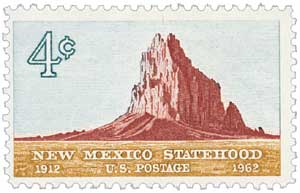
U.S. #4591
2012 44¢ New Mexico Statehood
Issue Date: January 6, 2012
City: Sante Fe, NM
Quantity: 50,000,000
Printed By: Avery Dennison
Printing Method: Photogravure
Perforations: Die Cut 11
Color: Multicolored
At dusk on a cool December night, six towering Shalako – messengers of the gods – dance to give thanks for the year’s bountiful harvest.
The Zuni are one of many tribes that call New Mexico home. According to legend, the Zuni’s ancestors came from the underworld in search of their “center” – where they could find water and security. Led by the water spider, they found the center of the earth at an anthill and built their home there.
Traditionally, the sun priest traveled to the sacred Thunder Mountain to fast and pray to the sun father. When he returned, preparations began for the Shalako ceremony. Today, mudheads, clown-like figures with mud masks, announce the festival.
The festival begins early in the morning with the arrival of the fire god who visits each house that will welcome a Shalako. Next comes the council of the gods, who dance and shake deer bones. By sunset, the Shalako arrive with headdresses of eagle feathers and masks with bulging eyes and wood beaks. The celebration lasts until noon the next day. As the Shalako exit, they perform their final prayer to fill the rivers, wells, and springs with water before the next summer.
Even 100 years after New Mexico became America’s 47th state, the Shalako festival is popular with Zuni and outsiders alike.
New Mexico Admitted As 47th State
Native Americans may have lived in New Mexico 20,000 years ago. Ancient spearheads found around Folsom and other sites indicate that Indians hunted there at least 10,000 years ago. The Mogollon Indians lived in the valleys near the New Mexico-Arizona border from about 500 B.C. to 1200 A.D.
The Anasazi Indians lived in the upper northwestern portion of New Mexico. These people had a remarkable civilization, raising corn and cotton and keeping domesticated turkeys. The Anasazi built large, apartment-style houses. One of these houses had between 600 and 700 rooms. The Pueblo Indians are the descendants of the Anasazi. The Navajo and Apache Indians came to the area around 1500 A.D. The Ute and Comanches settled there a short time later.
The first whites to reach New Mexico did so almost by accident. Álvar Núñez Cabeza de Vaca, a Spanish explorer looking for gold, was shipwrecked in Texas. Most of his crew drowned. After wandering for eight years, Cabeza de Vaca found a large Spanish settlement in what is now Mexico. The men shared stories about seven cities of phenomenal wealth, which they called the “Seven Cities of Cibola.” Cabeza de Vaca claimed the cities were located to the north. In 1539, Marcos de Niza, a priest guided by one of Cabeza de Vaca’s men, searched for the cities. Marcos de Niza claimed New Mexico for Spain during this expedition. Other explorers also searched the region for the Seven Cities of Cibola. Of course, none were successful. However, the explorations of Antonio de Espejo led to Spanish colonization of the area.

Spain established a colony in New Mexico in 1598. The colony was located at the Pueblo of San Juan de Los Caballeros, near the Chama River. Juan de Oñate, who became the governor of the province of New Mexico, financed it. Later, Pedro de Peralta became governor, and moved the capital to Santa Fe in 1609 or 1610. Today, Santa Fe is the oldest seat of power in the United States.
The colony was very poor and probably wouldn’t have survived if not for the efforts of Roman Catholic missionaries who wished to teach the Indians Christianity. There were many conflicts between the Spanish and Indians, and amongst the Spanish, between church and civilian authorities. The Spaniards imposed forced labor on the Indians in a system similar to slavery. Roman Catholic authorities forbade the Indians from worshiping their gods. In 1680, Popé led the Indians in a revolt against the Spanish. More than 400 Spanish were killed, and nearly every trace of the Roman Catholic Church was destroyed. In 1692, Diego de Varga retook the province with only minimal fighting. For the next 125 years, the Spanish and Indians lived together in relative peace.
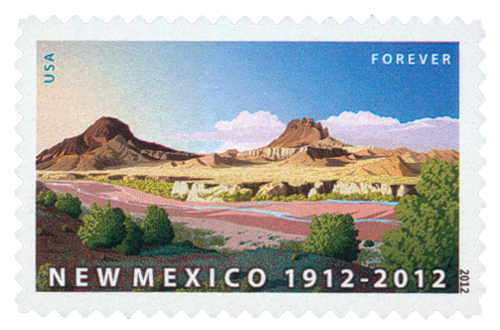
Mexico won its independence from Spain in 1821. New Mexico became a Mexican province. Also in 1821, American William Becknell blazed the Santa Fe Trail. This trail allowed goods to be shipped from New Mexico to Missouri. Mexico ruled New Mexico for 25 conflict-ridden years. Mexicans and Indians rebelled against the government in 1837. The rebels killed the governor and seized the Palace of Governors in Santa Fe. José Gonzales, a Taos Indian, took control of the province. A month later, Mexican General Manuel Armijo crushed the rebellion and established himself as governor.
In 1841, a small force from the Republic of Texas, at that time an independent nation, invaded New Mexico. The Texans attempted to claim the land east of the Rio Grande but the Mexican army easily defeated them.
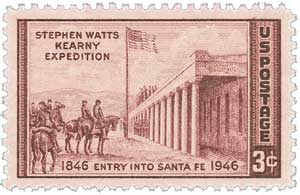
As American settlers moved westward, tensions increased between the U.S. and Mexico. In 1846, the Mexican–American War erupted. U.S. forces led by General Stephen W. Kearny easily captured New Mexico. The war ended in 1848, with the Treaty of Guadalupe Hidalgo. New Mexico was now U.S. property.
Congress created the territory of New Mexico in 1850. At that time the territory included today’s Arizona and parts of Colorado and Nevada. In 1853, the U.S. made the Gadsden Purchase from Mexico, acquiring land south of the Gila River. This land was added to the territory. In 1863, Congress created the Colorado and Arizona territories, and New Mexico received its present boundaries.
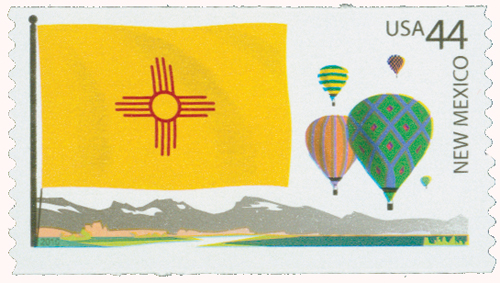
During the Civil War, Confederates from Texas took the territory of New Mexico. In March 1862, Union forces regained control. From 1862-64, a group of New Mexico settlers, led by famous frontier scout Kit Carson, fought to force the Mescalero Apache and Navajo Indians to live on reservations. During the late 1870s, the so-called Lincoln County War erupted. This conflict was waged for political control of this lucrative cattle country. The famous outlaw Billy the Kid, among others, took part in the fighting. In 1878, General Lew Wallace was appointed governor of the territory. To end the bloodshed, he granted a pardon to all the participants in the fighting. However, in 1881, Lincoln County sheriff Pat Garrett killed Billy the Kid. The Apache chief Victorio led attacks against New Mexico settlers from 1879 to 1880, when he died. One of the last hostile Apache leaders, Geronimo, wreaked havoc in the area until he surrendered on September 4, 1886.
New Mexico achieved statehood on January 6, 1912. At that time, the state had a population of about 330,000 people. Just a few years later Mexican rebels, perhaps led by the legendary Pancho Villa, attacked the town of Columbus and killed 17 people. The U.S. Army sent a force into Mexico to catch Villa, but they were unsuccessful.
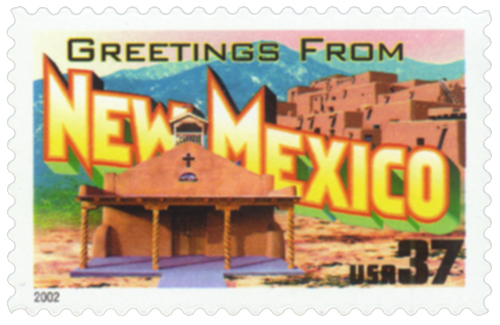
New Mexico supplied a large number of troops during both World War I and World War II. The world’s first atomic bomb was detonated at Trinity Site, near Alamogordo, New Mexico, on July 16, 1945. The bomb was created by scientists at the U.S. weapons research laboratory at Los Alamos, in the New Mexico Mountains. The use of two atomic weapons against Japan ended World War II.
New Mexico’s economy prospered due to its leadership in nuclear research. Today, the state continues to be a leading center in this area, as well as in space research. During the 1960s and ”˜70s, the state’s tourism income nearly doubled, and continues to contribute a great deal to the economy. New Mexico has benefited much from the construction of San Juan-Chama project, completed in the 1970s, which brings water to the state from branches of the San Juan River in the Rocky Mountain area. Reservoirs built for this water have created recreational areas and provide a much-needed irrigation resource.



